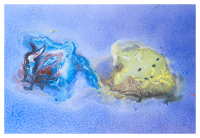Speaker
Keisuke Ohtani
(Tokyo Institute of Technology)
Description
The QCD sum rule method is a powerful tool for studying hadron properties directly from QCD.
In this method, the correlation function of an interpolating field operator coupled to the hadron of interest,
which can be calculated in the deep Euclidean region by the operator product expansion (OPE),
is related to the hadronic spectral function. The non-perturbative contributions in the correlation function
are expressed by vacuum condensates such as the chiral condensate.
In the traditional analysis, it is necessary to assume some specific functional form,
such as the ``pole + continuum"-ansatz, for the spectral function.
On the other hand, our approach with the help of the Maximum Entropy Method (MEM) is able to extract the spectral
function without assuming a specific form.
The method has been successfully applied to the rho meson sum rule [1] and the nucleon sum rule [2] in vacuum.
We have applied this analysis method of QCD sum rules to the spectral function of the nucleon and
its negative parity excited states in vacuum [3]. We construct the parity projected nucleon sum rules
including the first order \alpha_{s} corrections by using a phase-rotated Gaussian kernel.
Both the positive and negative parity spectral function of the nucleon are extracted after the MEM
is applied to the sum rule.
We find that the difference between the positive and negative parity spectral function is
mainly caused by the chiral condensate.
Applying this method to the analyses in nuclear medium, the mass modification of both the positive and
negative parity states can be examined.
An investigation of the nucleon spectral function in nuclear medium is now in progress.
[1] P. Gubler and M. Oka, Prog. Theor. Phys. 124, 995 (2010).
[2] K. Ohtani, P. Gubler and M. Oka, Eur. Phys. J. A 47, 114 (2011).
[3] K. Ohtani, P. Gubler and M. Oka, Phys. Rev. D 87, 034027 (2013).
Author
Keisuke Ohtani
(Tokyo Institute of Technology)
Co-authors
Makoto Oka
(Tokyo Institute of Technology)
Philipp Gubler
(RIKEN)
